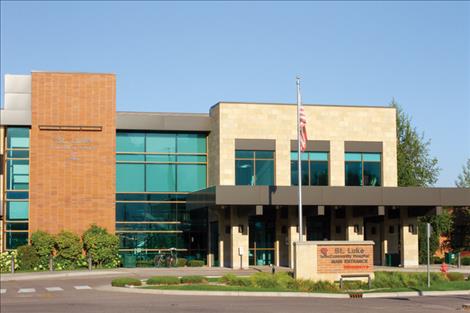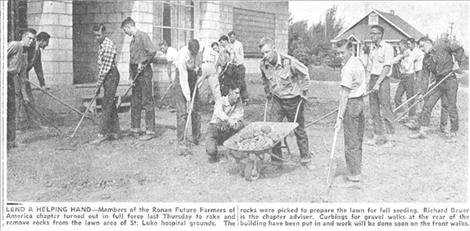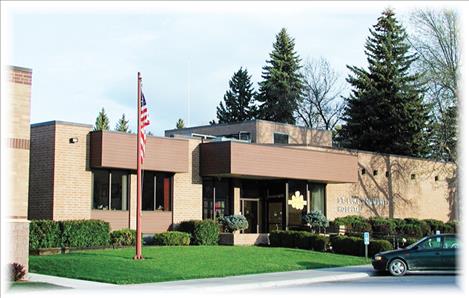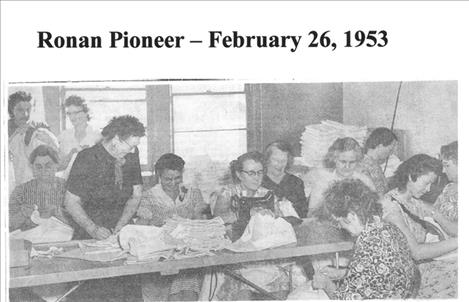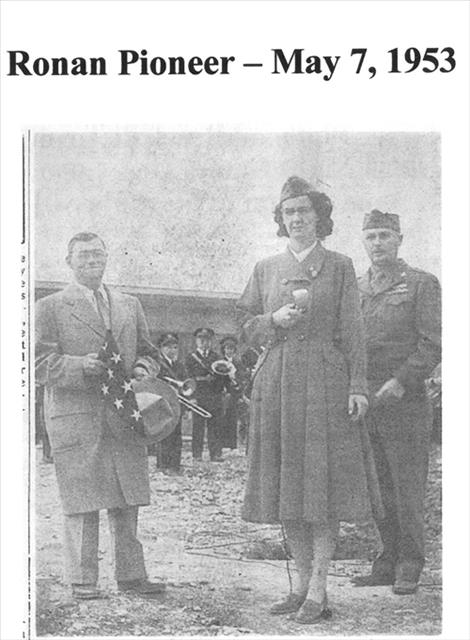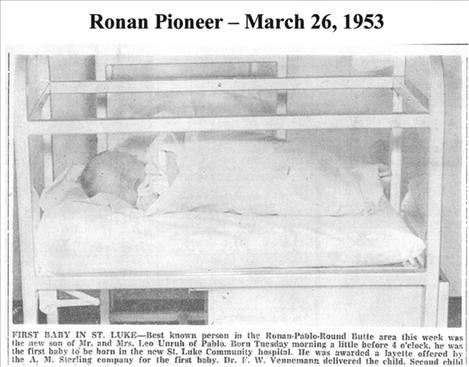St. Luke celebrates seven decades of serving community
Hey savvy news reader! Thanks for choosing local.
You are now reading
1 of 3 free articles.
RONAN — St. Luke Community Healthcare celebrated 70 years this month, a landmark for the community-owned healthcare organization.
Opened in March of 1953, St. Luke Hospital was built by Mission Valley residents from the ground up. “I think the community came together back in the late ‘40s and they realized they wanted to have a healthcare entity that was community owned and operated and not part of a big system or anything else, just really an organization that was dedicated solely to this community,” St. Luke CEO Steve Todd explained. “So, the community came together and fundraised and literally brought hammer and shovel in hand to build the organization.”
Todd has an old photo he said he likes to show at employee orientations of volunteers from the Future Farmers of America (FFA) chapter of Ronan working to develop the grounds of the hospital. “It’s just a great reminder of what this community did to help get it going,” Todd commented.
Community-owned since its inception, the organization has seen a lot of growth over the years to meet the needs of the local community. In Todd’s nearly 25 years on the job, there’s been the $28 million expansion of the new hospital facility that added around 60,000 square feet and remodeled the existing 30,000 square feet in 2008. The Ronan clinic was constructed and finished in 2001, the Ridgewater and Southshore clinics were built in Polson, and the oncology center was added to the main hospital’s second floor for outpatient chemotherapy treatment. The staff has also expanded from almost 200 employees to over 400 in that time.
“When I started there was a handful of doctors. Now we’ve got 20-plus physicians and caregivers that provide all sorts of not only primary care, but surgical care and a smattering of visiting specialists that provide additional surgery,” Todd said. “It’s amazing here, and I think part of that is we have a lot of staff that’ve been here 40 plus years, and that makes a difference. It’s really cool to see the loyalty and the dedication that the staff has to the community and I think that speaks volumes to where their priorities are and why we’ve been successful.”
Some employees of St. Luke have even been involved for generations. Leah Emerson, who now sits on the organization’s board, served as St. Luke Director of Nursing for 25 years. Her mother, Rosemary Miller, was her predecessor, and the organization offers a memorial scholarship to high schoolers every year in her name.
“I feel like I grew up there,” Emerson said of the hospital. “Those were interesting times. Completely different from now, 50 years later.” Emerson began work at St. Luke while she was still in high school, helping her grandmother – who was a cook at the hospital kitchen – do dishes after the evening meal until she was old enough to work as a nurse’s aide at age 16. After graduating from nursing school in 1974, Emerson initially began work at Holy Family Hospital in St. Ignatius, which no longer exists, before transferring fairly quickly to St. Luke. She worked the 3-11 shift while Miller (her mother) was the night shift nurse until taking the Director of Nursing job in 1976. When Miller retired in 1991, Emerson continued as a nurse for a couple more years before taking up the mantle of Director of Nursing herself in 1993.
“I was fortunate as the Nursing Director to be intimately involved in the development of plans for what is currently the newest part of the hospital,” Emerson said. “So that was very rewarding for me to be able to say what was important to nursing staff, what (is) important to patients, and have that incorporated into the architectural plans for the building.” Retired in 2018, Emerson even now still works for the hospital making calls to COVID-19 test patients.
Several generations of Emerson’s family have worked at St. Luke, with two of her sons holding jobs there for a time and her middle child currently acting as the Plant Manager. Her sister was a nurse there as well, along with several of their cousins, and her aunt was once the head of surgery.
“There are many, many other families for which that same thing is true. When you have a community hospital – and St. Luke is truly a community hospital – then there are other families that have made big commitments to that as well,” Emerson pointed out. “I think what happens in healthcare is it becomes a family tradition or a culture within a family … you grow up hearing the stories and living and breathing what your parents did or your aunts and uncles and cousins and it becomes just part of your family. And that’s what happens in small hospitals.”
Times weren’t always easy for the community hospital, Todd explained. When Todd’s predecessor, Shane Roberts, first began at St. Luke, the organization was in a difficult enough financial situation that Roberts had to go to, what was at the time, Ronan State Bank and ask for a loan to keep operations up and running. “Over time, he turned it around and the team turned it around and got it going successfully,” Todd said. “That’s a testament to (the staff’s) dedication, and fortunately we’ve been able to be successful and sustainable over my tenure and prior to that, so it’s been great. But it takes a lot of dedication, and the team really focused on the end goal, which is the best way we can take care of our community together.”
As many people at St. Luke commented, rural healthcare is different. Providers and staff alike have to wear many hats to best serve their community, and they end up treating the people they know – neighbors, friends, peers – more often than strangers. “(We) get a lot of joy and satisfaction in really seeing care having an impact versus in a big city,” Todd explained. “For us it’s about appreciating the community that’s been loyal to the organization and understands the need to be connected to an organization that’s community owned … We recognize people have a choice in healthcare, but to make us a preferred choice over the course of that time, it’s humbling.”
“I think St. Luke has just always been like a family,” Emerson stated. “Of course, it gets harder to maintain that family culture as it gets bigger and bigger … but there still is this sense of family that people who walk into the building – say physicians that come to interview for a position – they’ve commented on it on a regular basis. This place has a different feel. It’s friendly, everybody knows everybody, and oftentimes that’s what attracts people to come to the area … It was a good place to me for 50 years. I’d highly recommend it to others.”
“A big thank you to the staff,” Todd added. “Without them we couldn’t be here taking care of the community, and a big thank you to the community because without them and their dedication and loyalty we wouldn’t be here either.”















